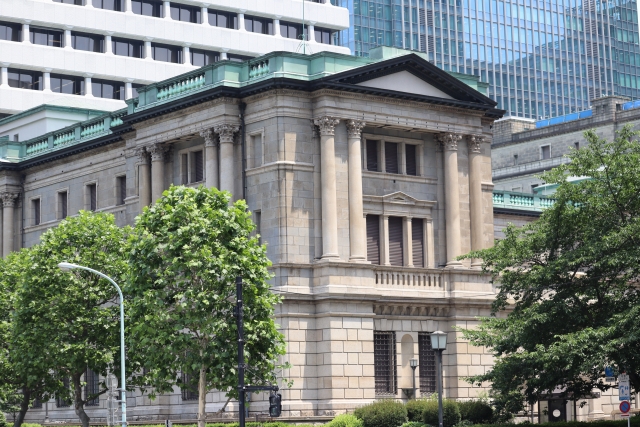Apr 8th, 2024
ビジネスに役立つ経済金融英語 第26回: 金融政策の枠組みの見直しについて(Changes in the Monetary Policy Framework)

日本銀行は3月19日の金融政策決定会合でマイナス金利政策を含む大規模緩和の解除を決めた。その政策表明「金融政策の枠組みの見直しについて」は、今後おそらく何年にもわたって繰り返し参照され、引用される資料的価値の高い文書だと思う。そこで今回はこの文書そのもの(日本語原文とその英訳)と、これを報じた日本および米国の記事を紹介して内容を振り返っていただこうと思う。
1.日本銀行の政策声明(金融政策の枠組みの見直しについて)を日本語と英語で読む
政策表明の内容については既に皆様もよくご存知のように、(1)マイナス金利解除、(2)長短金利操作撤廃、(3)ETF購入終了が骨子となっている。その内容を単にご紹介しても本連載の趣旨に合わないと思うので、発表文を日本語と英語で紹介する。 一文ごとに和英対照とし、読者の皆様の理解を促進するため、段落ごとにタイトルをつけた上で、おそらく、今後経済人のスピーチや新聞・雑誌記事などで何度も引用されるであろう重要な①経済・金融用語、②政策決定の背景(理由)、③歴史的に重要と思われる年や期間、金利水準等に下線を付した(各段落のタイトル、および文章内の下線、太字、注、記号等もすべて鈴木。なお本文中の(注1)(注2)は参加者の投票内容なので割愛した)。なお、後に紹介する「6.『ニューヨーク・タイムズ』(2024年3月18日配信)」と「7.『ウォール・ストリート・ジャーナル』(3月19日更新)」は原文が英語、日本語訳は鈴木である。
1-(1)背景と政策方針
金融政策の枠組みの見直しについて
Changes in the Monetary Policy Framework
2024年3月19日
日本銀行
日本銀行は、本日、政策委員会・金融政策決定会合において、賃金と物価の好循環を確認し、先行き、「展望レポート」の見通し期間終盤にかけて、2%の「物価安定の目標」が持続的・安定的に実現していくことが見通せる状況に至ったと判断した。
(At the Monetary Policy Meeting held today, the Policy Board of the Bank of Japan assessed the virtuous cycle between wages and prices, and judged it came in sight that the price stability target of 2 percent would be achieved in a sustainable and stable manner toward the end of the projection period of the January 2024 Outlook Report (Outlook for Economic Activity and Prices). )
これまでの「長短金利操作付き量的・質的金融緩和」の枠組みおよびマイナス金利政策は、その役割を果たしたと考えている。
(The Bank considers that the policy framework of Quantitative and Qualitative Monetary Easing (QQE) with Yield Curve Control and the negative interest rate policy to date have fulfilled their roles.)
日本銀行は、引き続き2%の「物価安定の目標」のもとで、その持続的・安定的な実現という観点から、短期金利の操作を主たる政策手段として、経済・物価・金融情勢に応じて適切に金融政策を運営する(a)。現時点の経済・物価見通しを前提にすれば、当面、緩和的な金融環境が継続すると考えている。
(With the price stability target of 2 percent, it will conduct monetary policy as appropriate, guiding the short-term interest rate as a primary policy tool, in response to developments in economic activity and prices as well as financial conditions from the perspective of sustainable and stable achievement of the target(a). Given the current outlook for economic activity and prices, the Bank anticipates that accommodative financial conditions will be maintained for the time being.)
以上を踏まえ、金融市場調節方針等については、以下のとおりとすることを決定した。
(On this basis, the Bank made the following decisions, including that on the guideline for market operations.)(a) マネタリーベースの残高に関するオーバーシュート型コミットメントについては、その要件を充足したものと判断する。
(The Bank judged that the inflation-overshooting commitment regarding the monetary base had fulfilled the conditions for its achievement.)
(参照先は以下の通り。
日本語:https://www.boj.or.jp/whatsnew/index.htm
英語:https://www.boj.or.jp/en/whatsnew/index.htm
より3月19日のそれぞれのタイトルをクリックしてください。以下同じです)
1-(2)具体的な措置
(1) 金融市場調節方針(賛成7反対2)( Guideline for market operations (a 7-2 majority vote)
次回金融政策決定会合までの金融市場調節方針は、以下のとおりとする。(The Bank decided to set the following guideline for market operations for the intermeeting period.)
無担保コールレート(オーバーナイト物) を、0~0.1%の範囲で推移するよう促す(b)。(The Bank will encourage the uncollateralized overnight call rate to remain at around 0 to 0.1 percent.(b))
(b) この方針を実現するため、日本銀行当座預金(所要準備額相当部分を除く)に0.1%の付利金利を適用する。新たな金融市場調節方針および付利金利は、翌営業日(3月21日)から適用する。
(In order to achieve this guideline, the Bank will apply an interest rate of 0.1 percent to current account balances held by financial institutions at the Bank (excluding required reserve balances). The new guideline for market operations and the new interest rate on the current account balances will be effective from March 21, 2024.)
(2) 長期国債の買入れ(賛成8反対1)
(Purchase of Japanese government bonds (JGBs ) (an 8-1 majority vote))これまでと概ね同程度の金額(c)で長期国債の買入れを継続する (The Bank will continue its JGB purchases with broadly the same amount as before.(c)) 。 長期金利が急激に上昇する場合には、毎月の買入れ予定額にかかわらず、機動的に、買入れ額の増額や指値オペ、共通担保資金供給オペなどを実施する(In case of a rapid rise in long-term interest rates, it will make nimble responses by, for example, increasing the amount of JGB purchases and conducting fixed-rate purchase operations of JGBs — both of which can be done so regardless of the monthly schedule of JGB purchases — and the Funds-Supplying Operations against Pooled Collateral.)。
(c) 足もとの長期国債の月間買入れ額は、6兆円程度となっている(The amount of JGB purchases is currently about 6 trillion yen per month.)。実際の買入れは、従来同様、ある程度の幅をもって予定額を示すこととし、市場の動向や国債需給などを踏まえて実施していく(The Bank will continue to announce the planned amount of JGB purchases with a range and will conduct the purchases while taking account of factors such as market developments and supply and demand conditions for JGBs.)。
(3) 長期国債以外の資産の買入れ(全員一致)
(Asset purchases other than JGB purchases (a unanimous vote))①ETFおよびJ-REITについて、新規の買入れを終了する。
(The Bank will discontinue purchases of exchange-traded funds (ETFs) and Japan real estate investment trusts (J-REITs).)②CP等および社債等について、買入れ額を段階的に減額し、1年後をめどに買入れを終了する。
(The Bank will gradually reduce the amount of purchases of CP and corporate bonds and will discontinue the purchases in about one year.)
(4) 貸出増加支援資金供給等の新規実行分の扱い(全員一致)
(Treatment of new loan disbursements under the Fund-Provisioning Measure to Stimulate Bank Lending etc. (a unanimous vote))貸出増加支援資金供給、被災地金融機関支援オペ、気候変動対応オペについては、貸付利率を0.1%、貸付期間を1年として実施する(The Bank will provide loans under the Fund-Provisioning Measure to Stimulate Bank Lending, the Funds-Supplying Operation to Support Financial Institutions in Disaster Areas, and the Funds-Supplying Operations to Support Financing for Climate Change Responses with an interest rate of 0.1 percent and a duration of one year.)。貸出増加支援資金供給については、貸出増加額と同額までの資金供給が受けられる仕組みとする(With regard to the Fund-Provisioning Measure to Stimulate Bank Lending, the maximum amount of funds that each eligible counterparty can borrow will be equivalent to the net increase in its amount outstanding of loans.)。
1-(3)国内経済の現状への評価と見通し
2.わが国の景気は、一部に弱めの動きもみられるが、緩やかに回復している(Japan’s economy has recovered moderately, although some weakness has been seen in part)。賃金を巡る環境を整理すると、企業収益は改善を続けており、労働需給は引き締まっている(Looking at the background conditions of wage developments, corporate profits have continued to improve and labor market conditions have been tight.)。こうしたもと、本年の春季労使交渉では、現時点の結果をみると、昨年に続きしっかりとした賃上げが実現する可能性は高く(In this situation, as indicated by the results of this year’s annual spring labor-management wage negotiations to date, it is highly likely that wages will continue to increase steadily this year, following the firm wage increase last year.)、本支店における企業からのヒアリング情報でも、幅広い企業で賃上げの動きが続いていることが窺われる(Moreover, anecdotal information from firms — which is gathered through the Bank’s Head Office and branches — suggests that a wide range of firms have maintained their stance of raising wages.)。物価面では、既往の輸入物価上昇を起点とする価格転嫁の影響は減衰してきているが、これまでの緩やかな賃金上昇も受けて、サービス価格の緩やかな上昇が続いている(On the price front, while the effects of a pass-through to consumer prices of cost increases led by the past rise in import prices have waned, services prices have continued to increase moderately, partly due to the moderate wage increases seen thus far.)。このように、最近のデータやヒアリング情報からは、賃金と物価の好循環の強まりが確認されてきており、先行き、見通し期間終盤にかけて、「物価安定の目標」が持続的・安定的に実現していくことが見通せる状況に至ったと判断した(As these recent data and anecdotal information have gradually shown that the virtuous cycle between wages and prices has become more solid, the Bank judged it came in sight that the price stability target would be achieved in a sustainable and stable manner toward the end of the projection period of the January 2024 Outlook Report.)。
以上が日本銀行の発表による政策声明だ。政府発表文の英語も、10年ほど前にはいかにも日本人が訳し、辞書を見ながら訳したような和製英文だったものが、英文の質が格段に上がっていると思う(あくまでも個人的な感想です)。

2.政策声明を受けた日米の新聞記事
次に、日本、米国の新聞報道の一部を紹介する。日本の各紙の報道はほぼこの声明に沿っている。参考までに政策声明発表直後の日本経済新聞と朝日新聞、『ウォール・ストリート・ジャーナル』、『ニューヨーク・タイムズ』のタイトルと第1段落、最終段落を紹介する。題材がこれだけ大きいと国が異なっても内容が似通ってくる。政策声明を日本語と英文で読んで、日本語の新聞を読みこなしていれば、この記事に関する限り英文記事をかなり読みこなせると思う。皆さんもどうぞ比較してみてください。
2-(1)日本経済新聞(2024年3月20日付/配信は19日)
日銀、金融正常化へ一歩 総裁「緩和的な金融環境継続」
(リード)日銀は19日の金融政策決定会合でマイナス金利政策を含む大規模緩和の解除を決めた。植田和男総裁は同日の記者会見で「賃金と物価の好循環の強まりが確認されてきた」と17年ぶりの利上げに踏み切った理由を説明した。「当面、緩和的な金融環境が継続すると考えている」とも述べ、追加の利上げを急がない考えも示唆した。
(第1段落)2007年2月の利上げを最後に一貫して緩和を続けてきた日銀の金融政策は正常化へ一歩、踏み出すことになる。
・・・(中略)・・・
(最終段落)13年に始まった大規模緩和は事実上終了し、金融政策は正常化に向けて新たな段階に入った。 世界の中央銀行は08年のリーマン・ショック以降、新型コロナウイルス禍への対応を含め金融緩和と引き締めを繰り返してきた。一貫して緩和を続けてきた日銀が正常化に向かうことで、世界の金融政策にとっても転機となる。
https://www.nikkei.com/article/DGXZQOUB145BH0U4A310C2000000/
2-(2)朝日新聞(2024年3月20日付朝刊一面)
日銀、異次元緩和を転換-マイナス金利解除、長短金利操作撤廃、ETF購入終了
(リード)日本銀行は19日の金融政策決定会合で、11年にわたる大規模な金融緩和策を終えると決めた。マイナス金利を解除して17年ぶりの利上げに踏み切り、長期金利を飛空抑え込む枠組みも撤廃する。手段、規模とも異次元の領域に踏み込んでいた日銀の金融政策は、歴史的な転換点を迎えた。
(第1段落)植田和男日銀総裁は記者会見で、今春闘での高い賃上げ率などから、物価上昇率2%の目標実現が見通せる状況になったと説明。大規模緩和は「役割を果たした」とし、今後は「普通の金融政策を行っていく」と語った。ただ、「当面、緩和的な金融環境が継続する」とも述べ、通常の手法での緩和は続ける。
・・・(中略)・・・
(最終段落)緩和の長期化により、日銀の国債保有額は約590兆円に上る。ETFを含め膨れあがった資産をどう減らしていくのかが重い課題となる。
(2024年3月20日付朝日新聞一面)
2-(3)『ウォール・ストリート・ジャーナル』(3月19日更新)
Bank of Japan Raises Rate, Halts Emergency Policies
(日本銀行、金利を引き上げ緊急政策を停止)
Central bank says stable inflation is in sight and ends unconventional asset purchases
(日本銀行は、物価安定の目標が見通せるに至ったとして、非伝統的な資産購入の終了を発表)TOKYO—The Bank of Japan on Tuesday ended negative interest rates after eight years and unwound most of its unorthodox monetary easing policies, saying a new era of stable inflation is in sight in Japan.
((東京発)日本銀行は19日(火)、8年間続けたマイナス金利を解除し、異次元緩和政策の大部分を解除した。これは、日本で安定したインフレの新たな時代が見通せる状況に至ったとの判断による)The decision marks the end of a global era of negative interest rates that began in the 2010s. Other central banks that had introduced negative rates in the 2010s, including the European Central Bank and the Swiss National Bank, have already moved back into positive territory amid inflation triggered by the Covid-19 pandemic and the war in Ukraine.
(この決定は、2010年代に始まった世界的なマイナス金利時代の終わりを告げるものだ。マイナス金利を導入していた他の中央銀行、例えば欧州中央銀行(ECB)やスイス国立銀行(SNB)も、新型コロナウイルスのパンデミックとウクライナ戦争が引き起こしたインフレの中、すでに正の領域へと回帰している)For a generation, the Japanese central bank served as a laboratory for monetary-policy experimentation as it addressed the country’s chronic stagnation, which was marked by flat or falling prices.
(日本銀行は、一世代(ほぼ30年)にわたって、物価が下落するか変わらないことを特徴する国の慢性的な停滞に対処するため、さまざまな金融政策の実験を実施してきた)On Tuesday, BOJ Gov. Kazuo Ueda said those policies have fulfilled their roles and the principal ones will be ended. The Bank of Japan is moving its key target for short-term rates to a range of 0% to 0.1%, its first rate increase since 2007.
(19日、日銀の植田総裁は、これらの政策が役目を果たしたので主要なものは終了すると述べた。日本銀行は短期金利の主要目標を0%から0.1%の範囲に移動させる。これは2007年以来の政策金利の引き上げである)Ueda said the move was justified by steadily rising wages and prices in Japan. The central bank “judged that sustainable and stable achievement of our 2% inflation goal has come into sight,” he said.
(植田総裁は、この措置は日本における賃金と物価の着実な上昇によって正当化されるとした。日銀は「2%の物価安定の目標が持続的・安定的に実現していくことが見通せる状況に至ったと判断した」と述べている。)・・・(中略)・・・
(最終段落)
“The Bank of Japan is unlikely to make additional rate increases because there will gradually appear more headwinds such as the lack of strength in prices,” said Mizuho Securities chief market economist Yasunari Ueno.
(「物価の力強さの欠如など、逆風が徐々に強まるため、日銀が追加利上げを行うことは考えにくい」とみずほ券の主席市場エコノミストの上野氏は語った)https://www.wsj.com/world/asia/bank-of-japan-ends-negative-interest-rates-888c9623?page=1
2-(4)『ニューヨーク・タイムズ 』(2024年3月18日配信)
Japan Raises Interest Rates for First Time in 17 Years(日本、17年ぶりに利上げ)
(リード)Higher inflation and rising wages suggest that the country’s economy can grow without such aggressive stimulus from the central bank.
(インフレ率と賃金の上昇は、中央銀行の積極的な刺激策なしでも日本経済が成長可能であることを示唆している)Japan’s central bank raised interest rates for the first time since 2007 on Tuesday, pushing them above zero to close a chapter in its aggressive effort to stimulate an economy that has long struggled to grow.
(日本銀行は2007年以来の利上げを実施してゼロ金利を解除し、長らく成長に苦しんできた経済を刺激する長期にわたる取り組みに一区切りをつけた)
In 2016, the Bank of Japan took the unorthodox step of bringing borrowing costs below zero, a bid to kick-start borrowing and lending and spur the country’s stagnating economy. Negative interest rates — which central banks in some European economies have also applied — mean depositors pay to leave their money with a bank and borrowers can take out loans very cheaply, an incentive for them to spend.
(2016年、日本銀行は借入コストをゼロ以下にするという異例の措置を取り、停滞する国内経済を活性化させようと借入れと貸し付けを促進しようとした。マイナス金利――一部の欧州諸国の中央銀行も適用している――は、預金者が銀行に金利を支払い、借り手が非常に安く融資を受けられることを意味し、それが消費を促すインセンティブとなる)
But Japan’s economy has recently begun to show signs of stronger growth: Inflation, after being low for years, has sped up, cemented by larger-than-usual increases in wages. Both are clues that the economy may be on a course for more sustained growth, allowing the central bank to tighten its interest rate policy years after other major central banks raised rates rapidly in response to a jump in inflation.
(最近になって日本経済は成長力が強まる兆しを見せている。インフレ率が長年の低迷から加速し、例年より大きい賃金の増加がこの流れを定着させようとしている。インフレ率、賃金ともに、経済が一段と持続的な成長への道を歩んでいることを示唆する手がかりであり、他の主要中央銀行がインフレの急騰に応じて政策金利を引き上げた数年後にようやく、日銀も金利政策を引き締められる余裕ができたというわけだ)
Even after Tuesday’s move, interest rates in Japan are far lower than those in the world’s other major developed economies. The Bank of Japan’s target policy rate was raised to a range of zero to 0.1 percent from minus 0.1 percent.
(19日の利上げ後も、日本の金利は世界の他の主要な先進経済と比較しても格段に低い。日本銀行の目標政策金利は、マイナス0.1パーセントからゼロ~0.1パーセントの範囲に引き上げられた。)・・・(中略)・・・
(最終段落)
Rising rates in Japan make investing in the country relatively more rewarding for investors, but the Federal Reserve’s target rate is still about five percentage points higher and the European Central Bank’s is four points higher. (日本の利上げは、投資家にとって日本への投資を相対的により魅力的なものにしているが、米連邦準備理事会(FRB)のFF金利の誘導目標は依然として約5パーセントポイント高く、欧州中央銀行(ECB)の政策金利も4ポイント高い)。While foreign investors have begun to funnel cash into the country, for Japanese investors the returns abroad are still attractive, stymieing a rapid repatriation of cash, even as the Fed and E.C.B. are expected to begin cutting rates.(外国人投資家が日本への投資を増やし始めているのに対し、日本の投資家にとっては海外でのリターンがなおも魅力的であり、FRBとECBが金利を引き下げ始めると予想されているにもかかわらず、急速な資金の再還流を阻んでいる)
(有料記事です)
https://www.nytimes.com/2024/03/18/business/bank-of-japan-interest-rates.html?searchResultPosition=1
どうだろう?普段あまり英字新聞を読みなれていない人でもあまりストレスなく読めたのではないだろうか?記事の一部なので、今回のイベントの歴史的な位置づけや諸外国との比較で報じている姿勢が感じられると思う。英字新聞といえばThe Japan Times(JT:独立系) やThe Japan News(JN:読売新聞発行。昔のThe Daily Yomiuri)の方が日本人には読みやすいと思うが、日本の記事に関しては、どうしても日本人の視点から見た日本の出来事に関する記事なので、この記事に関しては幅広い視点は得られにくいかもしれない(もっともJTはニューヨーク・タイムズ、JNはワシントン・ポストの主要記事がまとまって掲載されている)。手に取れる方は是非当時の新聞を図書館や会社でご欄いただきたい。
3.気になる重要表現
最後に、気になる重要表現を二つ取り上げておきたい。
(1)長短金利操作
いわゆるYCC(Yield Curve Control/イールドカーブ・コントロール)だ。日本経済新聞の「きょうのことば」にこの用語が定義されているのでこの機会に覚えておこう(もう終わっちゃったんですけど…)。
3-(1)日本経済新聞「きょうのことば―長短金利操作」
長短金利操作とは 日銀の金融緩和策の柱、副作用も
きょうのことば 2023年11月1日
▼長短金利操作 日銀が短期金利と長期金利の両方を目標の水準に誘導する金融緩和の枠組み。「イールドカーブ・コントロール(YCC)」とも呼ばれ、2016年9月に導入した。従来の伝統的な金融緩和は短期金利のみを操作対象としたのに対し、長短金利操作では残存年限(満期までの期間)ごとの金利をつなげた利回り曲線(イールドカーブ)全体を押し下げる。
日銀は短期金利(当座預金の一部に適用する金利)をマイナス0.1%、長期金利の誘導目標を「ゼロ%程度」としている。利回りを抑え込む手段として日銀が国債を購入する。指定した利回りで国債を無制限に買う指し値オペを手段として備える。
国債の大量購入に伴い債券市場の機能が悪化したことに配慮し、日銀は指し値オペを実施する長期金利の上限水準を徐々に引き上げてきた。22年12月にはそれまでの0.25%から0.5%に、今年7月には1%に引き上げた。10月には長期金利の上限は1%をめどとして、1%超えを容認。金融緩和を維持しつつ市場機能の改善をめざす。
(以下略)https://www.nikkei.com/article/DGXZQOUB303PC0Q3A031C2000000/
なお、ナスダック(Nasdaq)のウェブページには日銀のYCCに焦点を絞ったWhat is yield curve control, and why is it unconventional?(イールドカーブ・コントロールとは何か?なぜそれが非伝統的なのか?)という解説記事がある。日本語訳は載せないので、是非独力で読んでみてください。
https://www.nasdaq.com/articles/what-is-yield-curve-control-and-why-is-it-unconventional
(2)異次元緩和
「異次元・・・」はここ1,2年流行り言葉のように広まって、なぜかしぼんでいる(?)ように見えるが、元々は黒田前日銀総裁が使い始めた言葉。こちらも日本経済新聞の「きょうのことば」にこの用語が定義されている。
3-(2)日本経済新聞「きょうのことば―異次元緩和」
異次元緩和とは 日銀、デフレから脱却目指し2013年導入
きょうのことば 2023年2月15日
▼異次元緩和 日銀が2013年4月から始めた大規模な金融緩和政策。黒田東彦総裁が「量・質ともに次元の違う金融緩和を行う」と説明したことから「異次元緩和」と呼ばれる。資金供給量を大幅に増やして人々の期待に働きかけ、デフレ経済からの脱却を目指した。安倍晋三元首相の経済政策「アベノミクス」の第1の矢と位置づけられる。
正式名称は「量的・質的金融緩和」で、導入当初は2年程度で2%の物価上昇率を掲げた。世の中に供給するお金の「量」(マネタリーベース)を2年間で2倍に拡大すると約束し、長期国債や上場投資信託(ETF)など買い入れ資産の「質」も多様化した。円安・株高につながったが、物価2%目標は達成できない状況が続いた。
https://www.nikkei.com/article/DGXZQOUB1443K0U3A210C2000000/
では、これは英語では何と言うか?冒頭の日銀政策声明では「量的・質的金融緩和」の英訳としてQuantitative and Qualitative Monetary Easing (QQE)となっているのでこれが正式な英語名称となる。その俗称「異次元緩和」の英訳はいろいろあるようだ。今日ご紹介した記事の中では、2-(3)『ウォール・ストリート・ジャーナル』記事中の
unorthodox monetary easing policies
がそれにあたるし、引用はしなかったが、『ジャパン・タイムズ』には
When Kuroda first introduced his unprecedented monetary easing in 2013, his initial plan was to achieve the 2% inflation target within two years, but the goal remained elusive during his tenure, which ended last April.(2013年に黒田氏がunprecedented monetary easingを導入した当初、彼の計画は2年以内に2%のインフレ目標を達成することだったが、その目標は彼の任期が昨年4月に終わるまで達成されないままだった。」)
の部分は、文字通り訳せば「前例のない金融緩和」=異次元金融緩和と言えるだろうし、他にもunconventional monetary policy、extraordinary monetary policyという表現がある。
いずれもこれからは日本経済史の飾る歴史的な用語として語られることが多そうだ。しばらくは外国人のお客様に日本の金融政策を説明するための必須用語として押さえておきたい。
今回は日本銀行のゼロ金利解除という歴史的な政策転換をテーマに、日銀発表と日米の新聞の報道内容を、主に表現の面に焦点を当てて紹介した。実はコロナの時がとりわけそうだったのだが、世界の多くの国が同じニュースをほぼ同じ切り口から報道することは珍しいので、そういうニュースを好機ととらえてさまざまなメディアに目を通し比較することは、語学力養成の面からも、視点を広くする点からも有益だと思う。
では6月に!

























